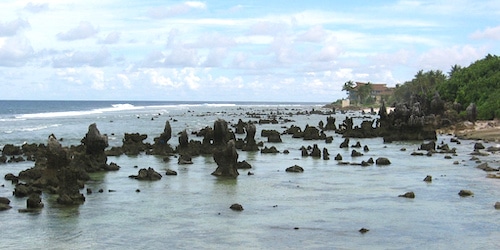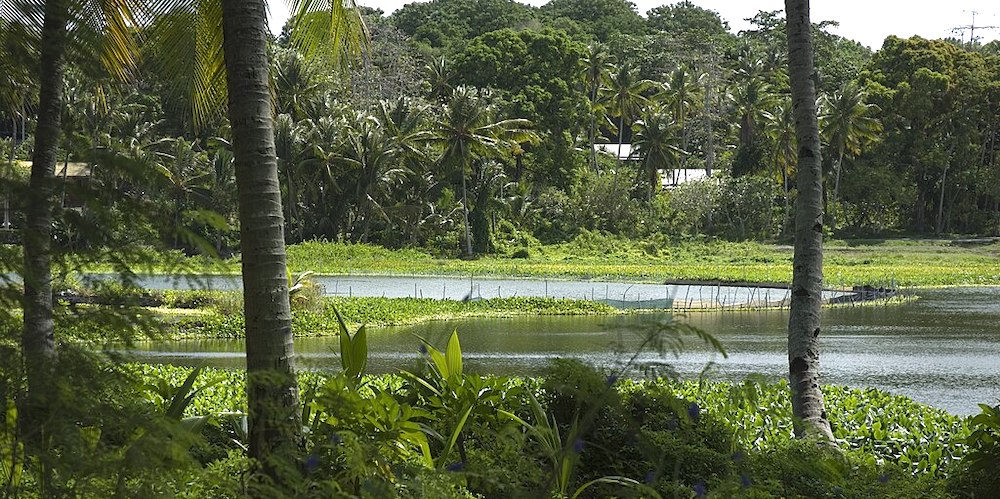Republic of Nauru

Nauru, formerly known as Pleasant Island, is an island country and micro-state in Micronesia, part of the Oceania region in the Central Pacific. Its nearest neighbour is Banaba of Kiribati about 300 km (190 miles) to the east. It lies northwest of Tuvalu, 1,300 km (810 miles) northeast of the Solomon Islands, east-northeast of Papua New Guinea, southeast of the Federated States of Micronesia and south of the Marshall Islands. With an area of only 21 km2 (8.1 square miles), Nauru is the third-smallest country in the world, larger than only Vatican City and Monaco, making it the smallest republic and island nation, as well as the smallest member state of the Commonwealth of Nations by area. Its population of about 12,000 is the world’s third-smallest (not including colonies or overseas territories). Nauru is a member of the United Nations and the Organisation of African, Caribbean and Pacific States.
Nauru is a phosphate-rock island with rich deposits near the surface, which allowed easy strip mining operations for over a century. However, this has seriously harmed the country’s environment. The phosphate was exhausted in the 1990s, and the remaining reserves are not economically viable for extraction. The island is surrounded by a fringing coral reef, which is exposed at low tide and dotted with pinnacles.

Coral reef on the beach in Nauru – ©d-online, CC BY-SA 2.0 via Wikimedia Commons
The presence of the reef has prevented the establishment of a seaport, although channels in the reef allow small boats access to the island. A fertile coastal strip 150 to 300 m wide lies inland from the beach, where coconut palms flourish. The land around Buada Lagoon supports bananas, pineapples, vegetables, pandanus trees, and indigenous hardwoods, such as the tamanu tree. Coral cliffs surround Nauru’s central plateau. The highest point of the plateau, called the Command Ridge, is 233 feet above sea level. Nauru’s climate is hot and very humid year-round because of its proximity to the equator and the ocean. Nauru is hit by monsoon rains between November and February. Annual rainfall is highly variable and is influenced by the El Niño–Southern Oscillation, with several significant recorded droughts. The temperature on Nauru ranges between 30 and 35 °C during the day and is quite stable at around 25 °C at night.
Birding Nauru
Fauna is sparse on the island because of a lack of vegetation and the consequences of phosphate mining. Many indigenous birds have disappeared or become rare owing to the destruction of their habitat. There are about 60 recorded vascular plant species native to the island, none of which are endemic. Coconut farming, mining, and introduced species have seriously disturbed the native vegetation. There are no native land mammals, but there are native insects, land crabs, and birds, including the endemic Nauru reed warbler. The Polynesian rat, cats, dogs, pigs, and chickens have been introduced to Nauru from ships. The diversity of the reef marine life makes fishing a popular activity for tourists on the island; also popular are scuba diving and snorkelling.

Buada Lagoon, Nauru – ©Lorrie Graham/AusAID via Wikimedia Commons
The plateau area contains large phosphate deposits that almost completely inhibit any natural growth useful for subsistence or commerce. Large areas of scrub and creeper, with occasional coconut and tamanu trees, grow in this region. On the coastal belt, coconut palms and pandanus (a type of screw pine) thrive. Some hibiscus, frangipani, and other tropical flowers grow, but they do not abound here as on other Pacific islands. Bird life is not plentiful, although noddies, terns, and frigate birds frequent the island. Fish life is abundant in the seas encircling Nauru and good catches of tuna and bonito are taken. There are limited natural fresh water resources on Nauru. Roof storage tanks collect rainwater, but islanders are mostly dependent on a single, aging desalination plant.
With just 34 bird species recorded Narau is not at the top on many birder’s list of must-see locations. However, there is the one endemic as well as plenty of opportunities to see some stunning seabirds.
-
Wikipedia
GNU Free Documentation License
https://en.wikipedia.org/wiki/Nauru
-
Number of bird species: 34
(As at January 2025)
Number of endemics: 1
Nauru Reed-warbler Acrocephalus rehsei
-
Avibase
PDF ChecklistThis checklist includes all bird species found in Nauru , based on the best information available at this time. It is based on a wide variety of sources that I collated over many years. I am pleased to offer these checklists as a service to birdwatchers. If you find any error, please do not hesitate to report them. -
Wikipedia
Annotated ListThere are 34 species of birds that have been recorded living in the wild in Nauru, one of which is endemic to the island and two of which have been introduced by humans. -
eBird
PDF ChecklistThis checklist is generated with data from eBird (ebird.org), a global database of bird sightings from birders like you. If you enjoy this checklist, please consider contributing your sightings to eBird. It is 100% free to take part, and your observations will help support birders, researchers, and conservationists worldwide.
-
BirdLife IBAs
WebsiteGeneral characteristics Nauru, an independent nation, is a raised limestone island (21 km2) in the west-central Pacific, and is a Secondary Area on the basis of its single-island endemic, Nauru Reed-warbler Acrocephalus rehsei -
The Birds of Nauru
PDF ReportThirty-four species of birds are recorded from the isolated Pacific island of Nauru. Six are treated as hypothetical pending corroboration; 3 others are introductions. Eighteen of the 25 indigenous species are non-breeding visitors (mainly migrating seabirds and shorebirds). The 7 confirmed or probable resident breeders include only 2 land birds, the Micronesian pigeon (Ducula oceanica) and the endemic Nauru reed-warbler (Acrocephalus rehsei). The Australian pelican (Pelecanus conspicillatus) and white-winged tern (Chlidonias leucopterus) are reported as first records for Nauru.
